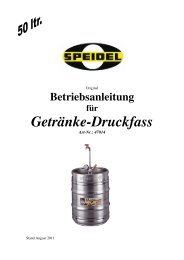Operating Instructions For Pressure Cask - Speidel Tank
Operating Instructions For Pressure Cask - Speidel Tank
Operating Instructions For Pressure Cask - Speidel Tank
You also want an ePaper? Increase the reach of your titles
YUMPU automatically turns print PDFs into web optimized ePapers that Google loves.
<strong>Pressure</strong> cask<br />
base frame. The room should be well ventilated and high temperatures or direct exposure<br />
to sunlight should be avoided.<br />
4.5 How to transport the pressure cask<br />
The beverage cask must only be transported after it has been depressurized. In order to<br />
prevent damage, the cask must be secured properly during transport.<br />
4.6 How to clean the beverage cask<br />
Please remember: hygiene is number one!<br />
Only if you sterilize the cask and the tap inside and outside immediately prior to filling<br />
the vessel can you be awarded with a delicious beverage. It is of utmost importance to<br />
clean the vessel properly the first time. Hygiene is important to guarantee your success.<br />
Therefore, SPEIDEL offers a cleaning brush that allows you to keep your pressure cask<br />
spick and span.<br />
When you are cleaning the vessel for the first time, use hot water to rinse it several times.<br />
Use the brush (supplied) to clean the tap. Once the pressurised beverage cask has been<br />
emptied, it must be cleaned thoroughly. Never let any remains become sticky and adhere<br />
to the inside/outside of the vessel. Before refilling the vessel it may remain under residual<br />
pressure; however, thorough cleaning shall always take place prior to the refilling<br />
process.<br />
Use commercially available cleaning agents to clean all stainless steel parts. Do not use<br />
abrasive cleaners or sponges and brushes that may cause scratches. Please ensure to<br />
remove all cleaning agent residue and rinse the pressurised beverage cask properly.<br />
Moreover, we also recommend to use baking powder as cleaning age. Fill the vessel with<br />
water. Add 1 to 3 packages of baking powder. Use the tap to close the cask and let it sit<br />
for 1 to 2 days. Subsequently, rinse thoroughly.<br />
These recommendations and instructions have been determined during numerous tests.<br />
Those values are based on experience; however, we cannot provide any guaranties. Never<br />
use chlorine or cleaning agents containing chlorine; it will damage the stainless steel.<br />
Before opening the beverage cask, ensure the vessel has been depressurized<br />
4.7 How to store the pressure cask<br />
The pressurised beverage cask must be stored in a dry place. Avoid any contact with<br />
ferrous or corroded equipment.<br />
Only operate the pressurised beverage cask and its ancillary equipment in well ventilated<br />
rooms in order to prevent the risk of suffocation caused by escaping CO2 (e.g., when<br />
bleeding the pressure relief valve).<br />
Never store pressurised vessels in direct sunlight or operate these vessels inside<br />
excessively hot rooms.<br />
Keep children away from all gas fittings, pressure relief valves or gas bottles.<br />
Page 6 of 16

















